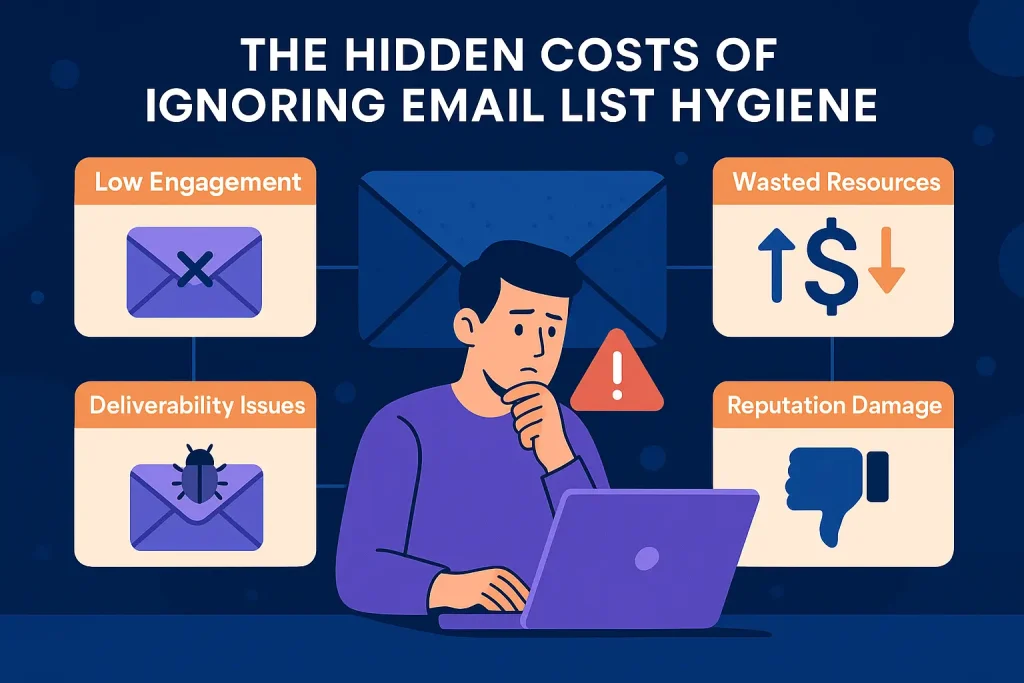Keeping your email list clean is key for any email marketing success. A clean list makes sure your messages get to the right people. This boosts engagement and helps you sell more.

Ignoring email list hygiene causes big problems. You might see lots of bounces, spam complaints, and hurt your reputation. This can make your email marketing less effective and cost you business.
Focus on email list hygiene to avoid these issues. This way, your email marketing can reach its best results.
Table of Contents
What Is Email List Hygiene and Why It Matters
A good email list is key for email marketing success. Email list hygiene means keeping your list clean and active. It’s about removing bad addresses and keeping the list fresh.
Definition and Core Components
Email list hygiene includes regular list cleaning, subscriber re-engagement, and proper list segmentation. These steps keep your list healthy and active.
| Core Component | Description |
|---|---|
| Regular List Cleaning | Removing inactive or bouncing email addresses |
| Subscriber Re-engagement | Reactivating inactive subscribers through targeted campaigns |
| Proper List Segmentation | Dividing the list into segments based on subscriber behavior and preferences |
The Foundation of Successful Email Marketing
Email marketing expert says, “A clean email list is not just a best practice, it’s a necessity for achieving high deliverability rates and maximizing ROI.” A healthy list is vital for email marketing success. It boosts deliverability, cuts spam, and raises engagement.
Signs Your List Needs Cleaning
Look out for high bounce rates, increased spam complaints, or low engagement rates. These signs mean your list needs a clean-up. Watching these metrics helps catch problems early.

The Hidden Costs of Ignoring Email List Hygiene
Not taking care of your email list can cost a lot more than you think. It’s not just about keeping your list clean. It’s about saving money and making your email marketing work better over time.

Immediate Financial Implications
Not keeping your email list clean can cause immediate financial losses. Sending emails to people who don’t want them wastes your time and money. This hurts your chances of getting people to open or click on your emails.
For example, sending ads to people who don’t want them is like throwing money away.
Long-term Revenue Impact
Ignoring your email list can hurt your money-making efforts over time. A dirty list can make it harder for your emails to get to people’s inboxes. This can hurt your brand’s image and lower your sales.
As your email reputation gets worse, reaching your audience becomes even harder. This makes your return on investment (ROI) go down.
Resource Allocation Problems
Having a dirty email list also wastes your time and money. The effort you put into sending emails to uninterested people could be used better. By cleaning your list and focusing on people who care, you can use your resources more wisely.
Diminished Deliverability: The Silent Revenue Killer
Your email list’s health affects how well your emails get delivered. Good email deliverability means your emails actually reach your subscribers.
How Poor Hygiene Affects Inbox Placement
Bad email list hygiene can hurt how often your emails land in the inbox. If your list has many dead or wrong addresses, it can make ISPs think your emails are spam.
This makes your current campaigns less effective. It also hurts your future email marketing plans. Keeping your email list clean helps your sender reputation and gets more emails into the inbox.
The Relationship Between Deliverability and ROI
Email deliverability and Return on Investment (ROI) are closely linked. When your emails get to the inbox, you’re more likely to get what you want, like leads or sales.
Improved deliverability means more chances for people to see and act on your emails. This can increase your ROI. But, bad deliverability can lower engagement and cut your revenue.
Case Studies: Deliverability Improvements
Many companies have boosted their deliverability by keeping their email lists clean. For instance, a business that cleaned its list and sent re-engagement emails saw a 25% increase in inbox placement rates.
- Regular list cleaning
- Re-engagement campaigns for inactive subscribers
- Monitoring of sender reputation
These steps not only improved deliverability but also made their campaigns better. This shows how important it is to keep your email list healthy.
Skyrocketing Bounce Rates and Their Consequences
High bounce rates can hurt your email marketing a lot. They show how healthy your email list is.
Hard vs. Soft Bounces
It’s important to know the difference between hard and soft bounces. Hard bounces happen when you send an email to a wrong or non-existent address. Soft bounces occur when an email is blocked by a server, maybe because the inbox is full.
How ESPs Penalize High Bounce Rates
Email Service Providers watch bounce rates closely. If they’re too high, they might think your emails are spam. This can block your emails.
Acceptable Bounce Rate Thresholds
Keeping bounce rates low is key. A rate under 2% is good. Rates over 2% might mean your list needs cleaning.
By handling bounce rates well, you can send more emails. And keep your email reputation safe.
Reputation Damage: Long-term Impact on Your Brand
A bad sender reputation hurts your brand more than just now. It makes ESPs and your audience trust you less.
How Email Reputation Scores Work
Email scores come from bounce rates, spam complaints, and how people interact with your emails. ESPs check these scores to see if you’re trustworthy. A high score means your emails get to the right people.
As noted by
“Email reputation is a critical component of email deliverability, and maintaining a good reputation requires ongoing effort and attention.”
This shows why you must always watch your email list and how you send emails.
The Domino Effect of a Poor Sender Reputation
A bad reputation can start a chain of problems. You might get fewer emails delivered, more spam filters, and even be blacklisted. This can really hurt your email marketing and your brand’s image.
If your emails are seen as spam, it hurts your current and future campaigns. It also makes your brand look bad.
Monitoring Your Sender Reputation
It’s key to keep an eye on your sender reputation. Use tools to check your reputation and fix problems early.
Keeping a good reputation helps your brand. It makes your email marketing work better for a long time.
Increased Spam Complaints: The Path to Blacklisting
When people don’t open your emails, they might mark them as spam. This hurts your reputation and makes it more likely you’ll get blacklisted.
Why Unengaged Subscribers Report Spam
People who don’t find your emails interesting might mark them as spam. This can happen if your list isn’t updated or if your content doesn’t match what they want. Keeping your list clean and your emails interesting is key to avoid spam.
Getting Off Blacklists: Time and Resources Wasted
Being blacklisted is a big problem for email marketers. It takes time and effort to get off the list. While you’re trying, your emails might not reach anyone. This can cause lost sales and harm your brand.
Preventing Spam Complaints Proactively
To stop spam complaints, you need to act early. Regularly clean your email list and segment your audience to send the right content. Also, make it easy for people to unsubscribe to avoid complaints.
Compliance Risks and Legal Consequences
Email marketing has many risks that can cause big legal problems. Businesses need to keep up with changing rules to avoid big fines and harm to their reputation.
GDPR, CAN-SPAM, and Other Regulations
Email marketers must follow many rules. The GDPR in the EU and the CAN-SPAM Act in the US are key. The GDPR wants clear consent before sending emails. The CAN-SPAM Act needs clear ways to opt out and true header info.
Canada’s CASL also has strict rules for email marketing. Knowing these rules is key to staying legal.
| Regulation | Key Requirements | Geographic Scope |
|---|---|---|
| GDPR | Explicit consent, data protection | European Union |
| CAN-SPAM | Clear opt-out, accurate headers | United States |
| CASL | Consent, identification, unsubscribe mechanisms | Canada |
Penalties for Non-Compliance
Not following email marketing rules can lead to big fines. GDPR fines can be up to €20 million or 4% of a company’s global income. The CAN-SPAM Act fines can be up to $43,280 for each bad email.
How Clean Lists Reduce Legal Exposure
Keeping your email list clean helps avoid legal trouble. By cleaning your list often, you send emails only to people who want them. This lowers the chance of breaking rules.
“The key to avoiding legal issues in email marketing is to prioritize list hygiene and adhere to regulatory requirements.”
By following email marketing rules, businesses can avoid legal problems and risks.
Misleading Analytics: Making Decisions Based on Flawed Data
Dirty email lists can mess up email marketing metrics. This leads to bad choices based on wrong data. If your list has lots of inactive or bad emails, your campaign’s numbers look off.
How Dirty Lists Skew Performance Metrics
A dirty list can make important numbers like open rates look wrong. This happens because some emails don’t work or don’t count as opens. This messes up what we think about how well a campaign is doing.
Open Rate Distortion
Unengaged emails can make it seem like your emails are more popular than they are. For example, a high open rate might not mean much if many emails aren’t being opened.
Click-Through Rate Misrepresentation
Click-through rates can also be wrong because of inactive emails. A low rate might not show how good a campaign is if many people aren’t clicking.
The True Cost of Data-Driven Mistakes
Bad data can cost a lot of money. It can waste resources and make marketing plans not work. It also stops us from making our campaigns better.
| Metric | Dirty List Impact | Clean List Impact |
|---|---|---|
| Open Rate | Artificially inflated or deflated | Accurate representation of engagement |
| Click-Through Rate | Misrepresented due to unengaged subscribers | Reflects true campaign effectiveness |
| Conversion Rate | Skewed by inactive or invalid addresses | Accurately reflects campaign ROI |
Keeping your email list clean is key. It makes sure your data-driven decisions are right. Clean lists help your email marketing numbers be true and useful.
Best Practices for Maintaining Email List Hygiene
To get the most from your email marketing, keeping your list clean is key. A tidy list helps your emails get through and boosts how people interact with them. This means better results for your money.
Regular Cleaning Schedule Implementation
Having a regular cleaning schedule is a must. It means taking out old, bad, or complaining emails. This keeps you from being seen as spam and helps your good name.
Best practices include:
- Regularly scrubbing your list for hard bounces and spam complaints
- Using email verification tools to validate new subscriptions
- Segmenting your list to identify and re-engage inactive subscribers
Re-engagement Campaigns That Work
Re-engagement campaigns aim to bring back inactive subscribers. They can work well if done right.
Subject Line Strategies
Good subject lines are key for getting people to open your emails. Use personalization and make it urgent to get them to open.
Incentive Offers
Give special deals or free stuff to get inactive people back. It’s a great way to get them interested again.
Sunset Policies for Inactive Subscribers
A sunset policy means slowly removing inactive subscribers. It keeps your list healthy and protects your good name.
Tools and Services for List Maintenance
The right tools make keeping your list easy. Email verification services check new subscriptions. List cleaning tools find and remove bad emails.
Conclusion
Keeping your email list hygiene in check is key for good email marketing. If you ignore this, you might face big problems. These include lower delivery rates, more bounces, and damage to your reputation.
By cleaning and taking care of your email list, you can dodge these issues. This way, your email marketing will work better. Use best practices like regular clean-ups, campaigns to get people engaged again, and rules for inactive subscribers.
Knowing the The Hidden Costs of Ignoring Email List Hygiene is the first step. By focusing on email list hygiene, you protect your brand. You also get better delivery rates and more sales.
FAQ
What is email list hygiene and why is it important for email marketing?
Email list hygiene means keeping your email list clean. It removes old or bad email addresses. This helps your emails get delivered better and keeps your reputation good.
How often should I clean my email list to maintain good hygiene?
Clean your email list often. It depends on how big your list is and how often you send emails. Clean it every 3-6 months to keep it fresh.
What are the consequences of having a high bounce rate in email marketing?
A high bounce rate hurts your reputation. Email services might think your emails are spam. This makes it harder to send emails and lowers your success.
How can I reduce spam complaints and avoid being blacklisted?
Make sure people really want to get your emails. Send them stuff they like. Use clear unsubscribe links and respect people who don’t want to hear from you.
What are some best practices for maintaining a healthy email list?
Clean your list often and send emails people want to read. Use tools to help keep your list clean. Watch your email stats to see how you’re doing.
How does email list hygiene impact my email marketing ROI?
Keeping your list clean helps your emails get to the right people. This means more people open and click on your emails. It makes your email marketing more effective.
Can you explain the difference between hard and soft bounces in email marketing?
Hard bounces are when an email can’t be delivered because the address is wrong. Soft bounces are when an email can’t be delivered right now, but might later. Knowing the difference helps keep your list healthy.
How do ESPs penalize senders with high bounce rates or spam complaints?
ESPs might mark your emails as spam or block them. This can really hurt your ability to send emails and succeed with your marketing.




The impact of sender reputation is so underrated—people forget that even a few bad addresses can hurt deliverability across the board. It’s kind of like maintaining your credit score, but for email marketing.
Totally agree with the importance of list hygiene—I’ve seen firsthand how a bloated list can tank deliverability. One tactic that’s worked for me is running periodic win-back campaigns before cleaning out inactive contacts.